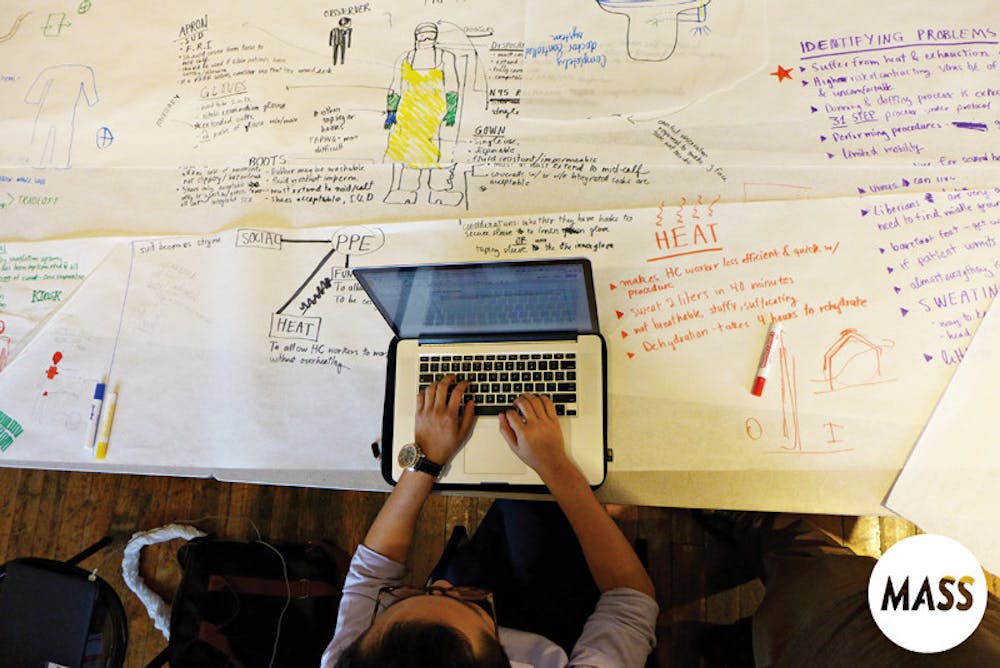As the international community grapples with the Ebola epidemic in West Africa, 50 community members from Brown and the Rhode Island School of Design have partnered to design safety equipment that protects workers treating the disease.
Students, professors and alums from both schools came together at a Nov. 8 conference titled “Fighting Ebola with Design” to explore temporary emergency infrastructure for doctors treating the disease and to empower community members to help stem the spread.
Nathan King, an assistant professor of architecture and foundation studies at RISD and director of design research at the Model of Architecture Serving Society Design Group, spearheaded the effort to create the day-long event in conjunction with both universities after hearing about the United States Agency for International Development’s competition titled “Fighting Ebola: A Grand Challenge for Development.”
“Few opportunities have the urgency that (the Ebola epidemic) has,” King said. “There was an urgency to push people to make (the response) happen, and it was one of the first times so many disciplines came together to do that.”
The event’s attendees were guided by Brown and RISD faculty members, MASS employees, doctors and other health industry professionals. Participants were divided into 10 different task forces, each with a unique prompt related to helping contain the Ebola epidemic.
The task forces first familiarized themselves with the situation by doing online research and listening to presentations given by doctors and other professionals. By lunchtime, each task force had decided on a project idea and begun working on making that idea a reality through diagrams and prototypes.
Project ideas included improving personal safety equipment and making information about Ebola more accessible.
Alexander Hadik ’15 and his group developed an inexpensive care kit that would enable people to treat an ailing family member at home for a limited number of days. The kit comprises a five-gallon bucket and comes with basic safety equipment, cleaning supplies and informational graphics. The materials inside the bucket are color-coded and arranged so that there is a clear division between what patients and caretakers may touch. The contents of the bucket are placed so the equipment that the caretaker will need first is on top, thereby simplifying the task of figuring out which protective equipment to put on first.
“Producing a package of supplies wasn’t good enough,” Hadik said, adding that a care kit would only be effective in preventing the spread of Ebola to family members if its designers considered it “from a user-centered perspective.”
Deb Rosenberg, a RISD graduate student, also examined ways of helping people outside of Ebola treatment centers. Her group developed an idea for a radio program that could broadcast optimistic messages and stories. Her group also came up with the idea of a text message system to give people in remote areas access to information, as well as to help track the spread of the disease.
“With such a high death rate and such an infectious disease, fighting against Ebola may seem like a lost cause to some people,” Rosenberg said. The goal of the radio program is “to raise people’s spirits and give them a sense of hope that people can beat this thing.”
Task forces also tackled problems related to the safety equipment worn by doctors treating Ebola patients. RISD senior Melissa Ponce and her group redesigned the helmet and garments that doctors wear when treating those infected.
The helmets that doctors currently wear only reveal their eyes, giving them a somewhat alien-like appearance, and current garments can only be worn for 45 minutes at a time before the hazmat suit and helmet overheat, Ponce said. As a result, the group tried designing a new helmet that was more open and therefore made it easier for air to ventilate and using cooling pads to cool down the suit.
“We covered the helmet in clear plastic, so that the patient can see the full face of the doctor,” Ponce said. “We’re trying to humanize the doctors and help foster that contact” between doctors and patients, he added.
The designs from the event were submitted to the USAID challenge online. There is no word yet on whether the designs will be implemented, but for now, King and others hope the conversation between the health and design communities will continue.
“I have high hopes, in that I think this is a real precedent in some ways, where a global or national organization looks to designers to help solve health problems,” Rosenberg said. “Designers are a real untapped resource in this situation. It’s time to think outside the box.”

ADVERTISEMENT




